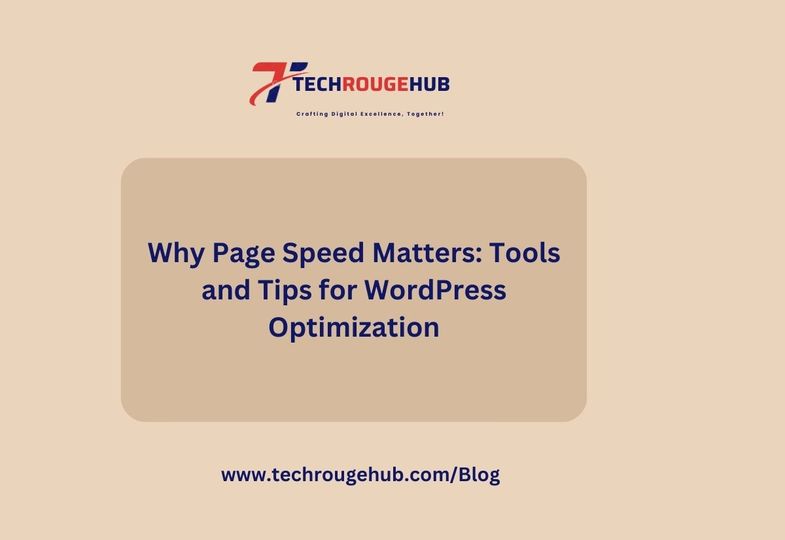In the fast-paced digital world, the speed at which your website loads can make or break your online presence. Page speed is not just a technical metric—it’s a critical factor that affects user experience, search engine rankings, and ultimately, your bottom line. If you’re running a WordPress site, optimizing page speed should be at the top of your to-do list. In this blog, we’ll explore why page speed matters, the tools you can use to measure and improve it, and actionable tips for WordPress optimization.
Why Page Speed Matters
1. User Experience and Engagement
When it comes to website performance, users have high expectations. Studies show that if a website takes longer than 3 seconds to load, 53% of visitors will abandon it. Slow page speed frustrates users, leading to higher bounce rates and lower engagement. On the other hand, a fast-loading site provides a seamless experience, encouraging visitors to stay longer, explore more pages, and convert into customers.
2. SEO and Search Rankings

Google has made it clear that page speed is a ranking factor in its search algorithms. A slow website can negatively impact your search engine optimization (SEO) efforts, pushing your site lower in search results. This decrease in visibility can significantly reduce organic traffic, which is crucial for driving leads and sales. Google’s Core Web Vitals, which include metrics like Largest Contentful Paint (LCP) and First Input Delay (FID), directly assess how quickly your site loads and responds to user interactions.
3. Mobile Optimization
With the majority of web traffic coming from mobile devices, mobile page speed is more important than ever. Mobile users expect even faster load times, and a slow mobile site can result in lost traffic and revenue. Google’s mobile-first indexing means that the performance of your mobile site is now the baseline for how your entire site is indexed and ranked.
Tools to Measure Page Speed
Before you can optimize your site, you need to know where you stand. Here are some essential tools to measure your WordPress site’s page speed:
1. Google PageSpeed Insights
Google PageSpeed Insights is a free tool that analyzes the content of your web pages and provides suggestions for making them faster. It scores your website on a scale of 0 to 100, with higher scores indicating better performance. The tool also offers specific recommendations for both mobile and desktop versions of your site.
2. GTmetrix
GTmetrix is another popular tool that provides detailed insights into your site’s speed performance. It generates a comprehensive report that includes page speed score, YSlow score, load time, page size, and the number of requests. GTmetrix also offers actionable suggestions to improve your site’s speed.
3. Pingdom
Pingdom is known for its simplicity and accuracy in testing website speed. It provides insights into various performance metrics such as page load time, file size, and the number of requests. Pingdom also allows you to test your site from different locations around the world, giving you a global perspective on your site’s performance.
4. WebPageTest
WebPageTest is an advanced tool that allows you to run tests on your site from multiple locations and browsers. It provides a wealth of data, including first-byte time, start render time, and fully loaded time, making it ideal for users who want in-depth insights into their site’s performance.
Tips for Optimizing WordPress Page Speed

Once you’ve measured your page speed, it’s time to optimize. Here are some practical tips to boost your WordPress site’s performance:
1. Optimize Images
Large image files are often the main culprits behind slow page load times. Optimize your images by compressing them without sacrificing quality. You can use plugins like Smush or Imagify to automatically compress images as you upload them to WordPress.
2. Use a Caching Plugin
Caching can significantly reduce the time it takes for your site to load. A caching plugin like W3 Total Cache or WP Super Cache creates static versions of your pages, reducing the load on your server and speeding up delivery to your users.
3. Minimize HTTP Requests
Every element on a web page—images, scripts, CSS files—requires an HTTP request. The more requests, the slower your site. Minimize HTTP requests by combining files, reducing the number of images, and using CSS sprites.
4. Enable Gzip Compression
Gzip compression reduces the size of your web files, which decreases the time it takes to load your site. Many caching plugins have an option to enable Gzip compression, or you can enable it manually by adding a few lines of code to your .htaccess file.
5. Optimize Your Database
Over time, your WordPress database can become cluttered with unnecessary data, which can slow down your site. Use a plugin like WP-Optimize to clean up your database, removing revisions, spam comments, and other junk.
6. Use a Content Delivery Network (CDN)
A CDN stores copies of your website on servers around the world, delivering content to users from the nearest server. This reduces latency and speeds up load times, especially for international visitors. Popular CDN options include Cloudflare and MaxCDN.
7. Choose a Fast and Reliable Hosting Provider

Your hosting provider plays a significant role in your site’s performance. Opt for a hosting provider that specializes in WordPress and offers features like SSD storage, built-in caching, and optimized server configurations. Managed WordPress hosting providers like WP Engine or SiteGround are excellent choices.
Conclusion
Page speed is a critical factor that influences user experience, SEO, and overall website success. By understanding its importance and using the right tools and techniques, you can optimize your WordPress site to deliver faster, smoother experiences for your users. Implement these tips, regularly monitor your site’s performance, and stay ahead of the competition in today’s fast-paced digital landscape.
If you need expert assistance with optimizing your WordPress site, TechRougeHub is here to help. Contact us to learn more about our web development and optimization services.

